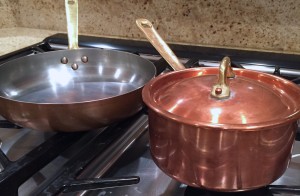Copper Cookware
Copper is an essential trace mineral in all body tissues. Copper and iron help form red blood cells. Copper also helps to keep your blood vessels, nerves, immune system and bones healthy. Copper is found naturally in certain types of shellfish, whole grains, potatoes, dried fruit and dark leafy greens. Most people get enough copper in their daily diets. The specific amount of copper needed daily depends on your age, gender and health situation. Copper in large amounts is poisonous, though a specific toxic amount has not been determined.
Nothing conducts heat like copper, not aluminum, not iron, not ceramic, and not stainless steel. Copper pots have benefits and disadvantages. Copper is attractive and shiny when used on the outside of pots and pans and copper is an excellent conductor of heat. Because of its look and superior heat conduction, copper cookware tends to be more expensive than other types of cookware. Uncoated copper cookware is highly toxic, but copper coated with tin, stainless steel or nickel is considered very safe. Tin coating being the most popular among the linings. Tin is non-reactive and rarely toxic to humans. Pure tin is as non-stick a cooking surface as can be found besides Teflon®. Food lifts off pure tin much as it does from well-seasoned steel, but tin does not require seasoning – its crystaline structure is already very smooth. Pure tin is molecularly and chemically inert – it does not react to variations in pH nor impart either flavor or volatile compounds to your food. It is not hydrophilic. It does very slowly oxidize, turning darker with time, and it does impart some of those flavorless oxides to acidic foods, much as iron imparts oxides of iron when you cook in it. The end result of cooking in tin is you get a tiny bit more tin in your diet, an essential nutrient of which we need.
In conclusion, for most people copper coated cookware is safe when used correctly except for people with Wilson disease. Anyone with Wilson disease should stay away from cooking with copper cookware altogether.
Wilson disease is a genetic disease that prevents the body from removing extra copper. The body needs a small amount of copper from food to stay healthy; however, too much copper is poisonous. Normally, the liver filters extra copper and releases it into bile. Bile is a fluid made by the liver that carries toxins and wastes out of the body through the gastrointestinal tract. In Wilson disease, the liver does not filter copper correctly and copper builds up in the liver, brain, eyes, and other organs. Over time, high copper levels can cause life-threatening organ damage.
http://www.mayoclinic.org/diseases-conditions/wilsons-disease/basics/definition/con-20043499
https://en.wikipedia.org/wiki/Copper_toxicity
http://www.whatmyhomewants.com/is-copper-cookware-safe/

